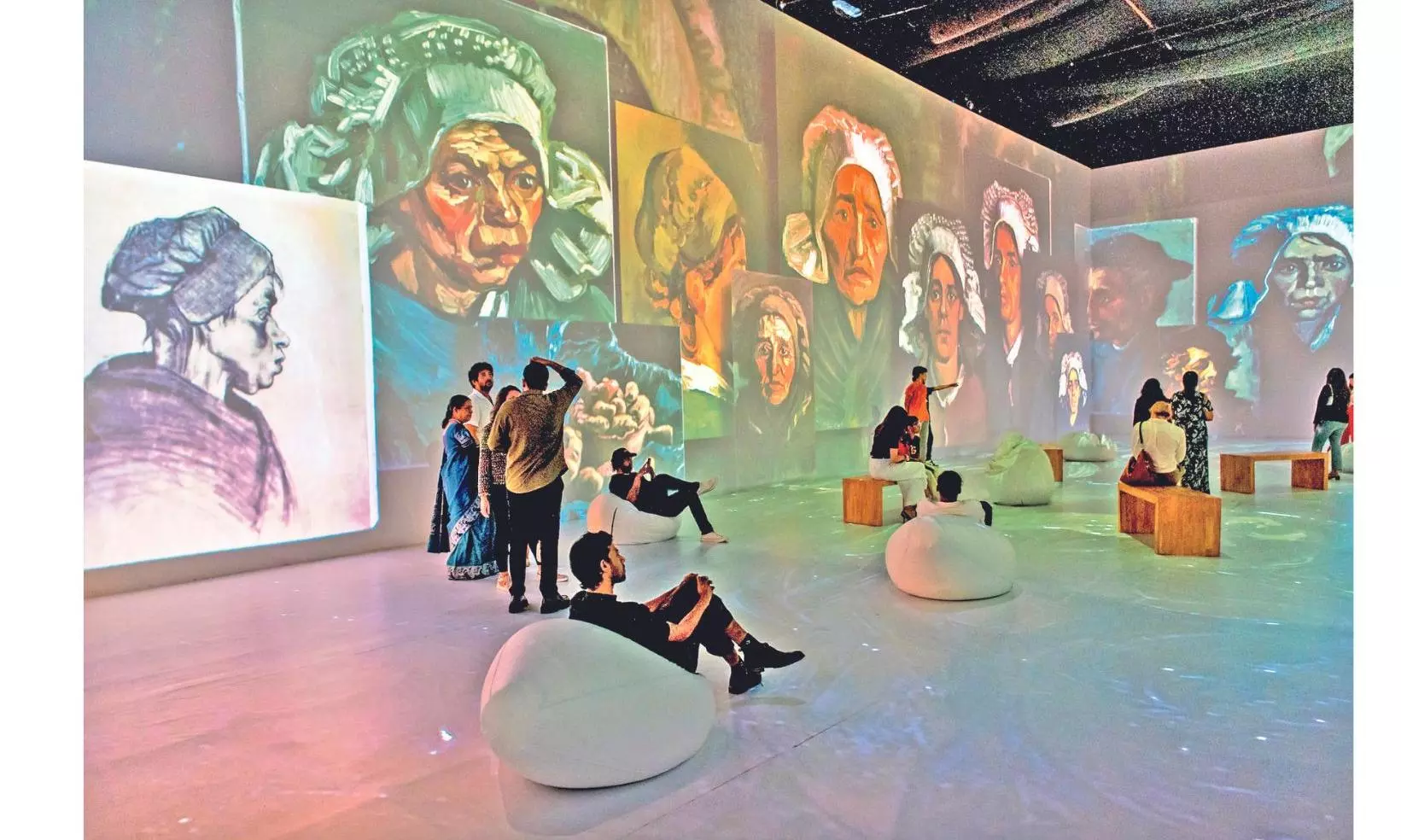Get Immersed
It is an invitation to not only see but also feel, touch, and interact with the work, making immersive art the preferred art experience for many art connoisseurs

It’s engrossing, fascinating, immersive, and undeniably captivating. It’s an experience. The way we consume art is changing. Dive into the world of immersive art.
The sensory wonderland awakens the senses and transfers the viewer into the artwork, enhancing their reality and daily life. Meta CEO Mark Zuckerberg believes that digital viewing methods will someday supplant conventional art and media. It’s no surprise that immersive art is a rapidly expanding artistic phenomenon that has swept the art world.
The most spectacular demonstration of the phenomenon has been Beyond Van Gogh: The Immersive Experience, which transforms the artist’s stunning paintings from two-dimensional to three-dimensional, fully immersive sceneries that swirl and flow with colour and movement, making it stimulating in every sense.
Dutch artist Vincent Van Gogh’s paintings are some of the most popular in the world and are housed in many museums and some private collections worldwide.
Visitors are taken on a voyage through the artist’s universe from darkness to light, aided by his own visions, thoughts, and words set to a stirring orchestral accompaniment, in this thrilling narrative experience that appeals to a new generation of art aficionados and Van Gogh lovers alike.
“Immersive art transports you to a completely new world. It’s almost like travelling into outer space for the first time or discovering the wonders that lie deep under water in the oceans. Most people’s first reaction to encountering immersive art is one of amazement. We have usually observed that most people just stand back, stunned, and take in all the colours and scale of the projections,” says Nikhil Chinapa, executive producer of Real Van Gogh Experience, a 3D exhibition of paintings by the 19th-century Dutch artist.
“An immersive experience isn’t just about seeing the paintings; it also brings to life an artist’s life and personality. It’s a completely new experience than being in a museum,” adds Nikhil.
Making art accessible to the masses
In a traditional museum or art gallery, exhibitions are shown, and visitors are expected to experience them quietly and contemplatively. Immersive art events and exhibitions, on the other hand, employ technology and involvement to present art in new and fascinating ways. “Museums can be intimidating and even boring to visit. However, immersive experiences elicit a reaction. In fact, it’s built into the experience. Twirl, smile, laugh, and pose for photos. But arguably the most important reason for its appeal is that it’s an enjoyable and shareable social media experience. Social media interaction has become an important part of public art and how art experiences are developed,” adds Nikhil.
Are they a threat or an opportunity for traditional galleries and museums?
“As a gallery owner, I see the rise of immersive art not as a threat but as an opportunity for the art world. It encourages a broader audience to experience art in new and exciting ways. This can potentially increase the number of visitors to all forms of art, including traditional galleries and museums,” says Lakshmi Nambiar, Gallerist, Shrishti Art Gallery.
Traditional art in the digital era
Art has always been a means of expression, a link between an artist’s inner world and the physical world. However, the rise of immersive art experiences is upending this traditional canvas, changing passive onlookers into active participants and resulting in a sensory wonderland that defies physical limitations, believes artist Laxman Aelay. He also says, “The rise of immersive art, fuelled by technologies such as augmented reality, does provide a fresh and fascinating method to view artistic creations. While some may consider it a logical progression in art appreciation, others may perceive it as a deviation from established forms. As immersive art challenges traditional conceptions of art consumption and interpretation, its acceptance and influence are likely to differ among individuals and within the art community.”
Art represents the fullness of life and, thus, is immersive in general. “It has the intensity in terms of form, colour, and thought to truly immerse oneself in it. The meaning of ‘art’ has evolved because art has become a daily part of our lives today. Through the way we do our interiors, clothes, and lifestyles, art is an effortless part of it. Personally, for me, art is created with a lot of heart, and any way of presenting it, if executed well, brings out the richness of the idea, whether it is traditional or through augmented reality,” says Venkat Gaddam, an artist and fashion designer.
Accept this unique creative style. After all, as Picasso famously stated, “Art washes away from the soul the dust of everyday life.”
Immersive art transports you to a completely new world. It’s almost like travelling into outer space for the first time or discovering the wonders that lie deep under water in the oceans. It also brings to life an artist’s life and personality. It’s a completely new experience than being in a museum. —Nikhil Chinapa, executive producer of Real Van Gogh Experience
I see the rise of immersive art not as a threat but as an opportunity for the art world. It encourages a broader audience to experience art in new and exciting ways. This can potentially increase the number of visitors to all forms of art.” — Lakshmi Nambiar, Gallerist, Shrishti Art Gallery.
Beyond Van Gogh: The Immersive Experience has been the most spectacular demonstration of the phenomenon, transforming the artist’s stunning paintings from two-dimensional to three-dimensional, fully immersive scenes that swirl and flow with colour and movement, stimulating the senses in every way.

